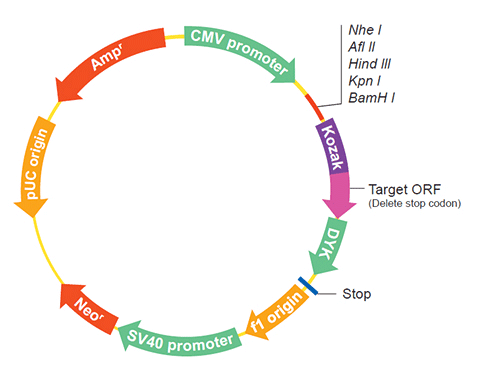| Gene Symbol | HMGA2 |
| Entrez Gene ID | 100271859 |
| Full Name | high mobility group AT-hook 2 |
| Gene Type | protein-coding |
| Organism | Canis lupus familiaris(dog) |
HOME
ORF » Species Summary » Canis lupus familiaris » HMGA2 cDNA ORF clone
| Gene Symbol | HMGA2 |
| Entrez Gene ID | 100271859 |
| Full Name | high mobility group AT-hook 2 |
| Gene Type | protein-coding |
| Organism | Canis lupus familiaris(dog) |
| mRNA | Protein | Name |
|---|---|---|
| XM_005625590.2 | XP_005625647.2 | high mobility group protein HMGI-C |
| XM_022424167.1 | XP_022279875.1 | high mobility group protein HMGI-C |


Derived variants at six genes explain nearly half of size reduction in dog breeds.
Rimbault M, Beale HC, Schoenebeck JJ, Hoopes BC, Allen JJ, Kilroy-Glynn P, Wayne RK, Sutter NB, Ostrander EA
Genome research23(12)1985-95(2013 Dec)
GeneRIFs: Gene References Into Functions What's a GeneRIF?
In lipomas, the increase of HMGA2 due to 12q14-15 chromosomal rearrangements is accompanied by an increased expression of p14Arf.
Title: Permanent activation of HMGA2 in lipomas mimics its temporal physiological activation linked to the gain of adipose tissue.
BMP4 acts in part by activating HMGA2 making this architectural transcription factor one of the major downstream players.
Title: BMP4 increases expression of HMGA2 in mesenchymal stem cells.
no difference in expression in dogs with lymphoma and control dogs
Title: Expression of the high mobility group A1 (HMGA1) and A2 (HMGA2) genes in canine lymphoma: analysis of 23 cases and comparison to control cases.
The following HMGA2 gene cDNA ORF clone sequences were retrieved from the NCBI Reference Sequence Database (RefSeq). These sequences represent the protein coding region of the HMGA2 cDNA ORF which is encoded by the open reading frame (ORF) sequence. ORF sequences can be delivered in our standard vector, pcDNA3.1+/C-(K)DYK or the vector of your choice as an expression/transfection-ready ORF clone. Not the clone you want? Click here to find your clone.
| CloneID | OCe291286 | |
| Clone ID Related Accession (Same CDS sequence) | XM_022424167.1 | |
| Accession Version | XM_022424167.1 Latest version! | Documents for ORF clone product in default vector |
| Sequence Information | ORF Nucleotide Sequence (Length: 231bp) Protein sequence SNP |
|
| Vector | pcDNA3.1-C-(k)DYK or customized vector |  User Manual User Manual |
| Clone information | Clone Map |  MSDS MSDS |
| Tag on pcDNA3.1+/C-(K)DYK | C terminal DYKDDDDK tags | |
| ORF Insert Method | CloneEZ™ Seamless cloning technology | |
| Insert Structure | linear | |
| Update Date | 2017-09-04 | |
| Organism | Canis lupus familiaris(dog) | |
| Product | high mobility group protein HMGI-C | |
| Comment | Comment: MODEL REFSEQ: This record is predicted by automated computational analysis. This record is derived from a genomic sequence (NC_006592.3) annotated using gene prediction method: Gnomon. Also see: Documentation of NCBI's Annotation Process ##Genome-Annotation-Data-START## Annotation Provider :: NCBI Annotation Status :: Full annotation Annotation Version :: Canis lupus familiaris Annotation Release 105 Annotation Pipeline :: NCBI eukaryotic genome annotation pipeline Annotation Software Version :: 7.4 Annotation Method :: Best-placed RefSeq; Gnomon Features Annotated :: Gene; mRNA; CDS; ncRNA ##Genome-Annotation-Data-END## | |
1 | ATGTCTGCGA AGGAGCCAAC CGGTGAGCCC TCTCCTAAGA GACCCAGGGG AAGACCCAAA |
The stop codons will be deleted if pcDNA3.1+/C-(K)DYK vector is selected.
| RefSeq | XP_022279875.1 |
| CDS | 16..246 |
| Translation |

Target ORF information:
Target ORF information:
|
 XM_022424167.1 XM_022424167.1 |

1 | ATGTCTGCGA AGGAGCCAAC CGGTGAGCCC TCTCCTAAGA GACCCAGGGG AAGACCCAAA |
The stop codons will be deleted if pcDNA3.1+/C-(K)DYK vector is selected.
| CloneID | OCe38814 | |
| Clone ID Related Accession (Same CDS sequence) | XM_005625590.2 | |
| Accession Version | XM_005625590.2 Latest version! | Documents for ORF clone product in default vector |
| Sequence Information | ORF Nucleotide Sequence (Length: 330bp) Protein sequence SNP |
|
| Vector | pcDNA3.1-C-(k)DYK or customized vector |  User Manual User Manual |
| Clone information | Clone Map |  MSDS MSDS |
| Tag on pcDNA3.1+/C-(K)DYK | C terminal DYKDDDDK tags | |
| ORF Insert Method | CloneEZ™ Seamless cloning technology | |
| Insert Structure | linear | |
| Update Date | 2015-09-16 | |
| Organism | Canis lupus familiaris(Dog) | |
| Product | high mobility group protein HMGI-C | |
| Comment | MODEL REFSEQ: This record is predicted by automated computational analysis. This record is derived from a genomic sequence (NW_003726077.1) and transcript sequence (KC529658.1) annotated using gene prediction method: Gnomon, supported by mRNA evidence. Also see: Documentation of NCBI's Annotation Process On Sep 17, 2015 this sequence version replaced XM_005625590.1. ##Genome-Annotation-Data-START## Annotation Provider :: NCBI Annotation Status :: Full annotation Annotation Version :: Canis lupus familiaris Annotation Release 104 Annotation Pipeline :: NCBI eukaryotic genome annotation pipeline Annotation Software Version :: 6.4 Annotation Method :: Best-placed RefSeq; Gnomon Features Annotated :: Gene; mRNA; CDS; ncRNA ##Genome-Annotation-Data-END## ##RefSeq-Attributes-START## assembly gap :: added 673 transcript bases to patch genome assembly gap ##RefSeq-Attributes-END## | |
1 | ATGAGCGCAC GCGGCGAGGG CGCCGGGCAG CCGTCCACTT CAGCGCAGGG ACAACCTGCC |
The stop codons will be deleted if pcDNA3.1+/C-(K)DYK vector is selected.
| RefSeq | XP_005625647.2 |
| CDS | 672..1001 |
| Translation |

Target ORF information:
Target ORF information:
|
 XM_005625590.2 XM_005625590.2 |

1 | ATGAGCGCAC GCGGCGAGGG CGCCGGGCAG CCGTCCACTT CAGCGCAGGG ACAACCTGCC |
The stop codons will be deleted if pcDNA3.1+/C-(K)DYK vector is selected.
Derived variants at six genes explain nearly half of size reduction in dog breeds. |